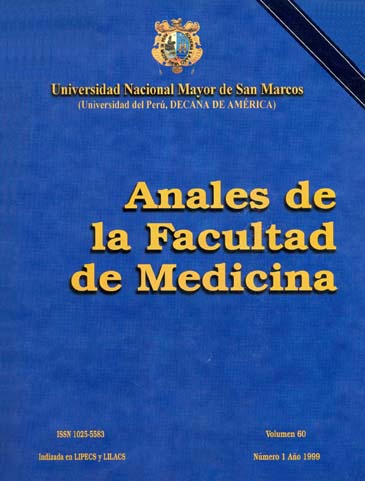Serum Growth Hormone and IGF-I Levels, and Submaximal Exercise at High Altitudes and Sea Level
DOI:
https://doi.org/10.15381/anales.v60i1.4495Keywords:
Somatotropin, Insulin-like Growth Factor I, Exertion, AltitudeAbstract
OBJETIVE: To assess serum growth hormone (GH) and insulin-like growth factor I (IGF-I) levels among high altitudes (HA) and sea level (SL) natives, and its variations with exercise. METHODS: 50 young men from Cerro de Pasco (4,340 m) and 40 individuals from Lima (150 m) were evaluated. Each subgroup underwent differentintensity exercise. Pre- and post-exercise hematocrit, hemoglobin, glucose, GH, IGF-I, insulin and glucagon levels were recorded. RESULTS: Baseline GH levels at SL showed no significant differences with those at HA (0,79 ng/mL vs. 0,98 ng/mL; p >0,05), whereas baseline IGF-I levels were higher at SL (299,38 ng/mL vs. 63,71 ng/mL; p <0,01). Among SL natives, there were a significant correlation between baseline GH and IGF-I (r = 0,44) levels. Submaximal exercise results in a significant rise of GH (0,79 to 5,54 ng/mL [r = 0,51] and 0,98 to 8,47 ng/mL [r = 0,51] at HA and SL, respectively) levels. On the other hand, exercise exert no significant variations on insulin, IGF1, glucagon or glucose levels. CONCLUSION: Submaximal exercise at HA and SL could result in high fasting GH levels observed in young adults, but it would not increase IGF-I and glucose levels.Downloads
Published
1999-03-15
Issue
Section
Trabajos originales
License
Copyright (c) 1999 Angel Pérez Valverde

This work is licensed under a Creative Commons Attribution-NonCommercial-ShareAlike 4.0 International License.
Those authors who have publications with this magazine accept the following terms:
- Authors will retain their copyrights and guarantee the journal the right of first publication of their work, which will be simultaneously subject to Creative Commons Attribution License that allows third parties to share the work as long as its author and its first publication this magazine are indicated.
- Authors may adopt other non-exclusive licensing agreements for the distribution of the version of the published work (eg, deposit it in an institutional electronic file or publish it in a monographic volume) provided that the initial publication in this magazine is indicated.
- Authors are allowed and recommended to disseminate their work over the Internet (eg: in institutional telematic archives or on their website) before and during the submission process, which It can produce interesting exchanges and increase quotes from the published work. (See El efecto del acceso abierto ).
How to Cite
1.
Pérez Valverde A. Serum Growth Hormone and IGF-I Levels, and Submaximal Exercise at High Altitudes and Sea Level. An Fac med [Internet]. 1999 Mar. 15 [cited 2024 Aug. 16];60(1):7-15. Available from: https://revistasinvestigacion.unmsm.edu.pe/index.php/anales/article/view/4495















